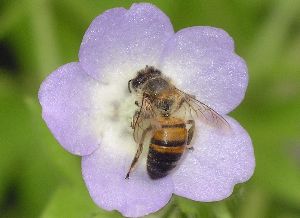by Larry
April, 2007A Sweet and Sour TaleVarious causes for the absence of bees have been speculated, from mysterious diseases to insecticide reactions, etc. The plain fact is that, just when they are in critical annual demand for commercial pollination requirements, beekeepers and farmers are having to make do with far fewer viable colonies than previously. Many beekeepers as well as entomologists are scratching their heads, admitting nothing like this and on this scale has been witnessed before.
Bees have been having problems for some time. Through the effects of loss of natural habitat, insecticides, parasites, and a growing number of diseases to which they are vulnerable, even with the influx and spread of bee populations from our southern neighbors, both wild and domestic bee populations in this country have dropped roughly in half over the past 50 years, per National Geographic News ("Bee Decline May Spell End of Some Fruits, Vegetables," by John Roach; October 5, 2004). There have been mites noted, for example, seriously weakening or killing our bees since the 1980s. Some think this country's original European honeybee species may have already been reduced to only 5% or less of their peak population numbers. It is hoped that, whatever is behind the present loss of bee colonies, termed "colony collapse syndrome" (CCD), solutions will be found either directly in nature or through human intervention. If the vacuum is not filled by wild bees, new colonies might be imported from still viable bee species areas. But, given the extent of the CCD phenomenon, all this could take plenty of time and be rather costly. And it is quite possible that the ways nature solves the problem would not be so satisfactory from a human standpoint. As one illustration, the less docile, Africanized or "killer bees" (now quite prevalent in the southwestern U.S., despite the problems with diminishing domestic European bee breeds elsewhere) may expand their territories, filling a vital need but bringing new hassles for safe bee handling. Besides the loss of honey production inherent in bees' flight, about one-third of U.S. foods depend entirely or in large part on honeybee pollination. If bees are now in severe decline, there will almost certainly be significant damage to our homegrown food supply as well as to major portions of the economy. In CA, for instance, almonds are a really big crop, providing 90% of the world's supply. They are 100% dependent on honeybees for pollination and growth.
Other domestic crops or trees heavily reliant on honeybees include apples, melons, blueberries, alfalfa, cherries, kiwi fruit, oranges, avocados, lemons, cucumbers, grapes, and many nuts. These are all non-native flora. Honeybees were not part of the biological mix prior to Europeans' and their agricultural heritage's entries into the western hemisphere.
As with abundant changes likely to be wrought by global warming, the processes, resolutions, and overall ramifications of this alteration in the pollination status quo are as yet unclear. At worst, several thousand beekeepers may lose their livelihoods, Americans may need to do without a substantial percentage of their preferred foods, and our agricultural and related industries will take a major economic hit over the next few years. At best, the missing bees will be replaced in short order, and the current puzzle of disappearing colonies will not turn out to be an important factor by next year's time for pollinating farm crops, fruit and nut trees, etc. More probably, of course, the impact will fall between the most pessimistic or optimistic scenarios, and will have lingering consequences. Will our monoculture style of farming (which puts great emphasis on just a relatively few plant species each dominating an area, that are then vulnerable to a single environmental change such as the loss of a local pollinating species) need to be adjusted? Will beekeepers need to stop the practice of shipping bees around the country to pollinate where and when they are needed, which some think may be too stressful for colonies? Will the trend continue of decline in honeybee populations, from sprawl, bee-eating moths or mites, viruses, fungi, ground species of bees being decimated (in the south) by fire ants, poor bee nutrition, stress, or insecticide effects? Will other natural pollinators be found to replace the now missing bees before major crop losses? Will the federal government step in to help sustain beekeepers and farmers financially until solutions can be worked out? Will we be required to buy our many bee dependent crops, at extra expense, from farms overseas where bee colonies still thrive? Or will some major foods now in our diets vanish soon after the demise of our bees? Stay tuned. Meanwhile, the plummeting bee population is merely one of many added challenges likely facing the nation's agricultural industry, along with rising temperatures in many places, more frequent droughts, higher average storm intensities, the expansion into new areas of highly successful predator species, more diseases to which crops and cattle are vulnerable, and so on. |
 A peculiarity of the crisis is that the worker bees have just taken off, either with their queens or leaving them to die in the hives untended. Might there be a microorganism or a commonly used pesticide that is affecting bees' orientation, weakening their immune systems, or heightening their susceptibility to stress? Though there is speculation, as yet the catalysts for a mass bee exodus have not been identified.
A peculiarity of the crisis is that the worker bees have just taken off, either with their queens or leaving them to die in the hives untended. Might there be a microorganism or a commonly used pesticide that is affecting bees' orientation, weakening their immune systems, or heightening their susceptibility to stress? Though there is speculation, as yet the catalysts for a mass bee exodus have not been identified.
